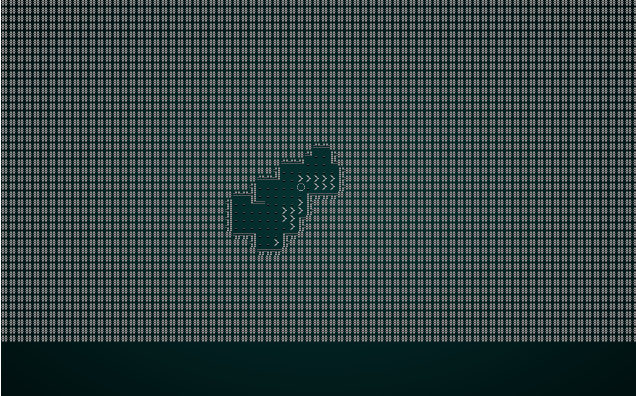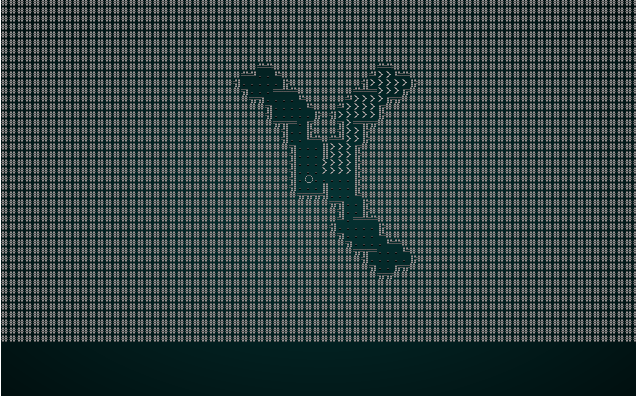Adding Symmetry and Brush Size as Library Functions
About this tutorial
This tutorial is free and open source, and all code uses the MIT license - so you are free to do with it as you like. My hope is that you will enjoy the tutorial, and make great games!
If you enjoy this and would like me to keep writing, please consider supporting my Patreon.
In the previous chapter on Diffusion-Limited Aggregation, we introduced two new concepts for map building: symmetry and brush size. These readily apply to other algorithms, so we're going to take a moment to move them into library functions (in map_builders/common.rs), make them generic, and demonstrate how they can alter the Drunkard's Walk.
Building the library versions
We'll start by moving the DLASymmetry enumeration out of dla.rs and into common.rs. We'll also change its name, since we are no longer binding it to a specific algorithm:
#![allow(unused)] fn main() { #[derive(PartialEq, Copy, Clone)] pub enum Symmetry { None, Horizontal, Vertical, Both } }
At the end of common.rs, we can add the following:
#![allow(unused)] fn main() { pub fn paint(map: &mut Map, mode: Symmetry, brush_size: i32, x: i32, y:i32) { match mode { Symmetry::None => apply_paint(map, brush_size, x, y), Symmetry::Horizontal => { let center_x = map.width / 2; if x == center_x { apply_paint(map, brush_size, x, y); } else { let dist_x = i32::abs(center_x - x); apply_paint(map, brush_size, center_x + dist_x, y); apply_paint(map, brush_size, center_x - dist_x, y); } } Symmetry::Vertical => { let center_y = map.height / 2; if y == center_y { apply_paint(map, brush_size, x, y); } else { let dist_y = i32::abs(center_y - y); apply_paint(map, brush_size, x, center_y + dist_y); apply_paint(map, brush_size, x, center_y - dist_y); } } Symmetry::Both => { let center_x = map.width / 2; let center_y = map.height / 2; if x == center_x && y == center_y { apply_paint(map, brush_size, x, y); } else { let dist_x = i32::abs(center_x - x); apply_paint(map, brush_size, center_x + dist_x, y); apply_paint(map, brush_size, center_x - dist_x, y); let dist_y = i32::abs(center_y - y); apply_paint(map, brush_size, x, center_y + dist_y); apply_paint(map, brush_size, x, center_y - dist_y); } } } } fn apply_paint(map: &mut Map, brush_size: i32, x: i32, y: i32) { match brush_size { 1 => { let digger_idx = map.xy_idx(x, y); map.tiles[digger_idx] = TileType::Floor; } _ => { let half_brush_size = brush_size / 2; for brush_y in y-half_brush_size .. y+half_brush_size { for brush_x in x-half_brush_size .. x+half_brush_size { if brush_x > 1 && brush_x < map.width-1 && brush_y > 1 && brush_y < map.height-1 { let idx = map.xy_idx(brush_x, brush_y); map.tiles[idx] = TileType::Floor; } } } } } } }
This shouldn't be a surprise: it's the exact same code we had in dla.rs - but with the &mut self removed and instead taking parameters.
Modifying dla.rs to use it
It's relatively simple to modify dla.rs to use it. Replace all DLASymmetry references with Symmetry. Replace all calls to self.paint(x, y) with paint(&mut self.map, self.symmetry, self.brush_size, x, y);. You can check the source code to see the changes - no need to repeat them all here. Make sure to include paint and Symmetry in the list of included functions at the top, too.
Like a lot of refactoring, the proof of the pudding is that if you cargo run your code - nothing has changed! We won't bother with a screenshot to show that it's the same as last time!
Modifying Drunkard's Walk to use it
We'll start by modifying the DrunkardSettings struct to accept the two new features:
#![allow(unused)] fn main() { pub struct DrunkardSettings { pub spawn_mode : DrunkSpawnMode, pub drunken_lifetime : i32, pub floor_percent: f32, pub brush_size: i32, pub symmetry: Symmetry } }
The compiler will complain that we aren't setting these in our constructors, so we'll add some default values:
#![allow(unused)] fn main() { pub fn open_area(new_depth : i32) -> DrunkardsWalkBuilder { DrunkardsWalkBuilder{ map : Map::new(new_depth), starting_position : Position{ x: 0, y : 0 }, depth : new_depth, history: Vec::new(), noise_areas : HashMap::new(), settings : DrunkardSettings{ spawn_mode: DrunkSpawnMode::StartingPoint, drunken_lifetime: 400, floor_percent: 0.5, brush_size: 1, symmetry: Symmetry::None } } } }
We need to make similar changes to the other constructors - just adding brush_size and symmetry to each of the DrunkardSettings builders.
We also need to replace the line:
#![allow(unused)] fn main() { self.map.tiles[drunk_idx] = TileType::DownStairs; }
With:
#![allow(unused)] fn main() { paint(&mut self.map, self.settings.symmetry, self.settings.brush_size, drunk_x, drunk_y); self.map.tiles[drunk_idx] = TileType::DownStairs; }
The double-draw retains the function of adding > symbols to show you the walker's path, while retaining the overdraw of the paint function.
Making a wider-carving drunk
To test this out, we'll add a new constructor to drunkard.rs:
#![allow(unused)] fn main() { pub fn fat_passages(new_depth : i32) -> DrunkardsWalkBuilder { DrunkardsWalkBuilder{ map : Map::new(new_depth), starting_position : Position{ x: 0, y : 0 }, depth : new_depth, history: Vec::new(), noise_areas : HashMap::new(), settings : DrunkardSettings{ spawn_mode: DrunkSpawnMode::Random, drunken_lifetime: 100, floor_percent: 0.4, brush_size: 2, symmetry: Symmetry::None } } } }
We'll also quickly modify random_builder in map_builders/mod.rs to showcase this one:
#![allow(unused)] fn main() { pub fn random_builder(new_depth: i32) -> Box<dyn MapBuilder> { /*let mut rng = rltk::RandomNumberGenerator::new(); let builder = rng.roll_dice(1, 12); match builder { 1 => Box::new(BspDungeonBuilder::new(new_depth)), 2 => Box::new(BspInteriorBuilder::new(new_depth)), 3 => Box::new(CellularAutomataBuilder::new(new_depth)), 4 => Box::new(DrunkardsWalkBuilder::open_area(new_depth)), 5 => Box::new(DrunkardsWalkBuilder::open_halls(new_depth)), 6 => Box::new(DrunkardsWalkBuilder::winding_passages(new_depth)), 7 => Box::new(MazeBuilder::new(new_depth)), 8 => Box::new(DLABuilder::walk_inwards(new_depth)), 9 => Box::new(DLABuilder::walk_outwards(new_depth)), 10 => Box::new(DLABuilder::central_attractor(new_depth)), 11 => Box::new(DLABuilder::insectoid(new_depth)), _ => Box::new(SimpleMapBuilder::new(new_depth)) }*/ Box::new(DrunkardsWalkBuilder::fat_passages(new_depth)) } }
This shows an immediate change in the map generation:
 .
.
Notice how the "fatter" digging area gives more open halls. It also runs in half the time, since we exhaust the desired floor count much more quickly.
Adding Symmetry
Like DLA, symmetrical drunkards can make interesting looking maps. We'll add one more constructor:
#![allow(unused)] fn main() { pub fn fearful_symmetry(new_depth : i32) -> DrunkardsWalkBuilder { DrunkardsWalkBuilder{ map : Map::new(new_depth), starting_position : Position{ x: 0, y : 0 }, depth : new_depth, history: Vec::new(), noise_areas : HashMap::new(), settings : DrunkardSettings{ spawn_mode: DrunkSpawnMode::Random, drunken_lifetime: 100, floor_percent: 0.4, brush_size: 1, symmetry: Symmetry::Both } } } }
We also modify our random_builder function to use it:
#![allow(unused)] fn main() { pub fn random_builder(new_depth: i32) -> Box<dyn MapBuilder> { /*let mut rng = rltk::RandomNumberGenerator::new(); let builder = rng.roll_dice(1, 12); match builder { 1 => Box::new(BspDungeonBuilder::new(new_depth)), 2 => Box::new(BspInteriorBuilder::new(new_depth)), 3 => Box::new(CellularAutomataBuilder::new(new_depth)), 4 => Box::new(DrunkardsWalkBuilder::open_area(new_depth)), 5 => Box::new(DrunkardsWalkBuilder::open_halls(new_depth)), 6 => Box::new(DrunkardsWalkBuilder::winding_passages(new_depth)), 7 => Box::new(MazeBuilder::new(new_depth)), 8 => Box::new(DLABuilder::walk_inwards(new_depth)), 9 => Box::new(DLABuilder::walk_outwards(new_depth)), 10 => Box::new(DLABuilder::central_attractor(new_depth)), 11 => Box::new(DLABuilder::insectoid(new_depth)), _ => Box::new(SimpleMapBuilder::new(new_depth)) }*/ Box::new(DrunkardsWalkBuilder::fearful_symmetry(new_depth)) } }
cargo run will render results something like these:
 .
.
Notice how the symmetry is applied (really fast - we're blasting out the floor tiles, now!) - and then unreachable areas are culled, getting rid of part of the map. This is quite a nice map!
Restoring Randomness Once More
Once again, we add our new algorithms to the random_builder function in map_builders/mod.rs:
#![allow(unused)] fn main() { pub fn random_builder(new_depth: i32) -> Box<dyn MapBuilder> { let mut rng = rltk::RandomNumberGenerator::new(); let builder = rng.roll_dice(1, 14); match builder { 1 => Box::new(BspDungeonBuilder::new(new_depth)), 2 => Box::new(BspInteriorBuilder::new(new_depth)), 3 => Box::new(CellularAutomataBuilder::new(new_depth)), 4 => Box::new(DrunkardsWalkBuilder::open_area(new_depth)), 5 => Box::new(DrunkardsWalkBuilder::open_halls(new_depth)), 6 => Box::new(DrunkardsWalkBuilder::winding_passages(new_depth)), 7 => Box::new(DrunkardsWalkBuilder::fat_passages(new_depth)), 8 => Box::new(DrunkardsWalkBuilder::fearful_symmetry(new_depth)), 9 => Box::new(MazeBuilder::new(new_depth)), 10 => Box::new(DLABuilder::walk_inwards(new_depth)), 11 => Box::new(DLABuilder::walk_outwards(new_depth)), 12 => Box::new(DLABuilder::central_attractor(new_depth)), 13 => Box::new(DLABuilder::insectoid(new_depth)), _ => Box::new(SimpleMapBuilder::new(new_depth)) } } }
We're up to 14 algorithms, now! We have an increasingly varied game!
Wrap-Up
This chapter has demonstrated a very useful tool for the game programmer: finding a handy algorithm, making it generic, and using it in other parts of your code. It's rare to guess exactly what you need up-front (and there's a lot to be said for "you won't need it" - implementing things when you do need them), so it's a valuable weapon in our arsenal to be able to quickly refactor our code for reuse.
The source code for this chapter may be found here
Run this chapter's example with web assembly, in your browser (WebGL2 required)
Copyright (C) 2019, Herbert Wolverson.
